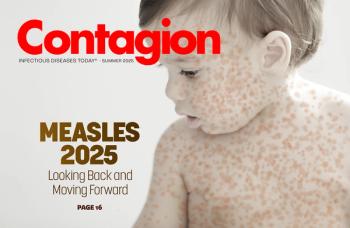
- April 2018
- Volume 3
- Issue 2
The Case of Late Aspergillus Fumigatus Infection of Implantable Cardioverter Defibrillator Leads
Quick action was needed against this very rare cause of fungal endocarditis.
HISTORY OF THE PRESENT ILLNESS
A 63-year-old male presented with persistent daily chills, lethargy, weakness, dyspnea on exertion, and weight loss for 2 months.
The patient had a recent admission, 2 months prior to presentation, for swelling over his implantable cardioverter defibrillator (ICD) site. At that time, purulent fluid from the ICD pocket was aspirated. Work-up of the specimen revealed <1 plus gram-variable bacilli and <1 plus yeast-like structures. The culture of the purulent fluid did not reveal any organisms, and multiple blood cultures were negative. A transesophageal echocardiogram (TEE) at the time showed a large clot in the superior vena cava and multiple mobile masses in the right ventricle, which were tethered to the ICD leads. These masses were thought to be thrombi, tumor, or vegetations. A biopsy of a superior vena cava mass was performed. Histological examination of the specimen showed acute inflammation and possible bacterial forms, but cultures did not reveal any pathogens. The patient was treated with a 7-day course of vancomycin, piperacillin/ tazobactam, and micafungin, and he was discharged home. The patient returned to the cardiology clinic for a visit 2 months later and was found to have a low hemoglobin. He complained of persistent chills, lethargy, and dyspnea on exertion, and so was instructed to return to the hospital.
PAST MEDICAL HISTORY
Severe pericardial effusion of unknown etiology treated with pericardial window, 5/2014; chronic systolic heart failure secondary to ischemic cardiomyopathy, with placement of dual-coil ICD for primary prevention of arrhythmia, November 20, 2007; myocardial infarction status post stent to left anterior descending coronary artery, July 26, 2007; hypertension, cardiac anterior wall aneurysm with apical clot status post a course of warfarin, 2003; left subclavian steal syndrome and superior vena cava narrowing, 2003; lung cancer in remote past with resection of right upper lobe.
MEDICATIONS
Aspirin, carvedilol, warfarin, simvastatin.
ALLERGIES
No known drug allergies.
EPIDEMIOLOGICAL HISTORY
Patient was born in Korea, immigrated to the United States more 20 years ago, and has traveled back to Korea several times since then. He has not traveled to any other countries. Has worked as owner of laundromat in Bronx, New York, for past 20 years. No history of intravenous drug use, no other illicit drug use. Social alcohol use. Ten pack a year history of smoking, quit 15 years ago. He has no pets and reports no animal exposure.
PHYSICAL EXAMINATION
The patient appeared chronically ill and fatigued. Blood pressure was 86/52 mm Hg, pulse 50 beats per minute, temperature 102.7°F, respirations 20 breaths per minute. Cardiac exam showed normal S1 and S2, regular rate and rhythm with a II/VI systolic murmur. Chest exam showed ICD in place at the left chest wall, without any warmth, edema, induration, or tenderness. Lungs were clear. Lower extremity exam showed trace edema.
STUDIES
Labs showed normal renal and liver function. Leukocyte count was 10.9 k/uL (normal range 4.8-10.8 k/uL) with 87% neutrophils; hemoglobin was 8.1 g/dL (normal range 14-17.4 g/dL); and hematocrit was 24.7% (normal range 41.5%- 50.4%). The C-reactive protein was elevated at 8.4 mg/dL (normal range 0.0-0.8 mg/dL) and the erythrocyte sedimentation rate was 140 mm/hr (normal range 0-20 mm/hr). Multiple blood cultures were obtained off antibiotics and antifungals and showed no growth.
Repeat TEE showed a large, mobile, multilobulated mass filling most of the right atrial cavity (3.6 x 5.1 cm) tethered to another large fixed mass fully encasing the superior vena cava with encasement of ICD leads. The echodensities appeared larger when compared with the previous TEE obtained 2 months prior.
DIAGNOSTIC PROCEDURES AND RESULTS
The patient underwent removal of the superior vena cava mass. In addition, the superior vena cava was debrided and reconstructed, and the ICD and leads were removed.
Pathology of the superior vena cava wall showed foci of necrosis with acute and chronic inflammation. Grocott-Gomori methenamine silver staining of the specimen revealed, within the foci of necrosis, fungal organisms which were morphologically consistent with Aspergillus, displaying septate hyphae with branching at an acute angle. This histopathological appearance was consistent with the diagnosis of angioinvasive aspergillosis. Cultures of the surgical specimens were unrevealing.
A sample was sent to the University of Washington, where a polymerase chain reaction targeting Aspergillus fumigatus came back positive. At the time of diagnosis and before the initiation of antifungal therapy, a serum sample for (1,3)-beta-D-glucan assay was found to be 418 pg/ml (Viracor-IBT Laboratories, Lee’s Summitt, MO; negative <60 pg/ml), while a serum Aspergillus galactomannan enzyme immunoassay was .149 optical density index (ODI) (Platelia Aspergillus ELISA, Bio-Rad, Hercules, CA) (normal cut-off <.5 ODI).
TREATMENT/FOLLOW-UP
The patient did well postoperatively and was discharged home on oral voriconazole. His ICD was re-implanted after 5 months of voriconazole therapy. The patient’s symptoms completely resolved and he was continued on voriconazole for 1 year, with (1,3)-beta-D-glucan assay after 1 year of therapy found to be negative at 56 pg/ ml. Voriconazole was stopped after 1 year of therapy with plans for quarterly assessment of (1,3)-beta-D-glucan and clinical monitoring.
DISCUSSION
Fungal endocarditis is associated with a high mortality rate, and survival depends on early diagnosis and treatment. Aspergillus is a very rare cause of fungal endocarditis. A recent review of all case report between 1950 and 2010 identified 53 cases of Aspergillus endocarditis. A total of 57% of cases had fever at presentation, and 53% had evidence of embolic disease. Blood cultures were almost always negative.1 To help establish diagnosis, (1,3)-beta-D-glucan may be a useful adjunctive test, but it has not been studied in Aspergillus endocarditis.
Infections account for <2% of the complications associated with cardiovascular implantable electronic devices, and only about 2% of these are secondary to a fungal pathogen.2 The first case of Aspergillus infection of a transvenous pacing lead was reported in the 1980s, and a limited number of cases have been documented in the literature since then.3 A review of the published cases showed that common risk factors include immunosuppression, long-term antibiotic or corticosteroid use, diabetes mellitus, heart failure, chronic kidney disease, prolonged hospitalization, and cardiothoracic surgery.4 TEE is the most accurate diagnostic test and is superior to transthoracic echocardiography for detecting vegetations on transvenous pacemakers or ICDs.5
The recommended antifungal for most invasive Aspergillus infections, including endocarditis, is voriconazole.6 There is no consensus on duration of treatment of ICD Aspergillus infection, but there is agreement that treatment is rarely successful unless the entire device is removed. Lifelong antifungal prophylaxis has been advocated in many series based on prior experience with Aspergillus native valve endocarditis, where late recurrent fungal endocarditis is common.7
Dr. Gancher is an assistant professor of medicine in the Division of Infectious Diseases & HIV Medicine at Drexel University College of Medicine where she is also the Director of Antimicrobial Stewardship. She completed a fellowship in infectious diseases at Albert Einstein College of Medicine & Montefiore Medical Center in Bronx, New York.
Dr. Chan is a professor in the Department of Medicine (Infectious Diseases) and Microbiology and Immunology at Albert Einstein College of Medicine in Bronx, New York.
Dr. Minamoto is an associate professor in the Department of Medicine (Infectious Diseases) at Albert Einstein College of Medicine in Bronx, New York.
Images contributed by Jack Jacob, DO.
References:
- Kalokhe AS, Rouphael N, El Chami MF, Workowski KA, Ganesh G, Jacob JT. Aspergillus endocarditis: a review of the literature. Int J Infect Dis. 2010;14(12):e1040-e1047. doi: 10.1016/j.ijid.2010.08.005.
- Sandoe JA, Barlow G, Chambers JB, et al; British Society for Antimicrobial Chemotherapy; British Heart Rhythm Society; British Cardiovascular Society; British Heart Valve Society; British Society for Echocardiography. Guidelines for the diagnosis, prevention and management of implantable cardiac electronic device infection. Report of a joint Working Party project on behalf of the British Society for Antimicrobial Chemotherapy (BSAC, host organization), British Heart Rhythm Society (BHRS), British Cardiovascular Society (BCS), British Heart Valve Society (BHVS) and British Society for Echocardiography (BSE). J Antimicrob Chemother. 2015;70(2):325-359. doi: 10.1093/jac/dku383.
- Moorman JR, Steenbergen C, Durack DT. Aspergillus infection of a permanent ventricular pacing lead. Pacing Clin Electrophysiol. 1984;7(3 Pt 1):361-366.
- Kodali A, Khalighi K. A case of late implantable cardiac device infection with Aspergillus in an immunocompetent host. Am J Case Rep. 2015;16:520-523. doi: 10.12659/AJCR.893413.
- Leong R, Gannon BR, Childs TJ, Isotalo PA, Abdollah H. Aspergillus fumigatus pacemaker lead endocarditis: a case report and review of the literature. Can J Cardiol. 2006;22(4):337-340.
- Walsh TJ, Anaissie EJ, Denning DW, et al; Infectious Diseases Society of America. Treatment of aspergillosis: clinical practice guidelines of the Infectious Diseases Society of America. Clin Infect Dis. 2008;46(3)327-360. doi: 10.1086/525258.
- Marchena Yglesias PJ, Rodríguez JA, García GA, Sanchís DV, Muños NS, Nuñez JF. Pacemaker lead infection caused by Aspergillus fumigatus. Eur J Intern Med. 2006;17(3):209-210. doi: 10.1016/j.ejim.2005.11.017.
Articles in this issue
over 7 years ago
Actively Involving Nurses in Antibiotic Stewardshipover 7 years ago
Drug-Resistant Gonorrhea and Other Emerging Issues in STIsover 7 years ago
Long-Acting Anti-MRSA Agents: One Dose to Cure?Newsletter
Stay ahead of emerging infectious disease threats with expert insights and breaking research. Subscribe now to get updates delivered straight to your inbox.





















































































































































































































































































